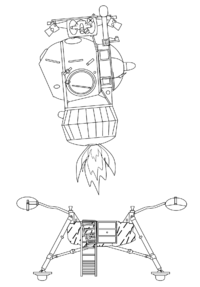Soyuz 8
Soyuz 8 (Russian: Союз 8, Union 8) was part of a joint mission with Soyuz 6 and Soyuz 7 that saw three Soyuz spacecraft in orbit together at the same time, carrying a total of seven cosmonauts.
).png)
| Mission type | Test flight |
|---|---|
| Operator | Soviet space program |
| COSPAR ID | 1969-087A |
| SATCAT no. | 4126 |
| Mission duration | 4 days, 22 hours, 50 minutes, 49 seconds |
| Orbits completed | 80 |
| Spacecraft properties | |
| Spacecraft type | Soyuz 7K-OK(P) |
| Manufacturer | Experimental Design Bureau OKB-1 |
| Launch mass | 6,646 kilograms (14,652 lb) |
| Crew | |
| Crew size | 2 |
| Members | Vladimir Shatalov Aleksei Yeliseyev |
| Callsign | Гранит (Granit - "Granite") |
| Start of mission | |
| Launch date | 13 October 1969, 10:19:09 UTC |
| Rocket | Soyuz |
| Launch site | Baikonur 31/6[1] |
| End of mission | |
| Landing date | 18 October 1969, 09:09:58 UTC |
| Landing site | 51°N 72°E |
| Orbital parameters | |
| Reference system | Geocentric |
| Regime | Low Earth |
| Perigee altitude | 201 kilometres (125 mi) |
| Apogee altitude | 227 kilometres (141 mi) |
| Inclination | 51.7 degrees |
| Period | 88.7 minutes |
Soyuz programme (Crewed missions) | |
The crew consisted of commander Vladimir Shatalov and flight engineer Aleksei Yeliseyev, whose mission was to dock with Soyuz 7 and transfer crew, as the Soyuz 4 (involving, among others, these two cosmonauts) and Soyuz 5 missions did. Soyuz 6 was to film the operation from nearby.
However, this objective was not achieved due to equipment failures. Soviet sources were later to claim that no docking had been intended, but this seems unlikely, given the docking adapters carried by the spacecraft, and the fact that both Shatalov and Yeliseyev were veterans of the previous successful docking mission. This was the last time that the Soviet-crewed Moon landing hardware was tested in orbit, and the failure seems to have been one of the final nails in the coffin of the programme.
The radio call sign of the spacecraft was Granit, meaning Granite. This word is apparently used as the name of a reactive or defensive squadron in Soviet military training, and, just like the Soyuz 5, it was constructed and its crew was trained to be the responsive (not entirely passive) or female spacecraft in its docking. Giving military names to the spacecraft was probably a response to an appeal that the commander of the Soyuz 5 made. Further, the word was probably chosen as it begins with a letter following that sequence starting with Antey (meaning Antaeus) and Buran (meaning Blizzard); Г (G) is the fourth letter of the Russian alphabet.
Crew
| Position | Cosmonaut | |
|---|---|---|
| Commander | Vladimir Shatalov Second spaceflight | |
| Flight Engineer | Aleksei Yeliseyev Second spaceflight | |
References
- "Baikonur LC31". Encyclopedia Astronautica. Retrieved 2009-03-04.

